Camera Lenses for Machine Vision
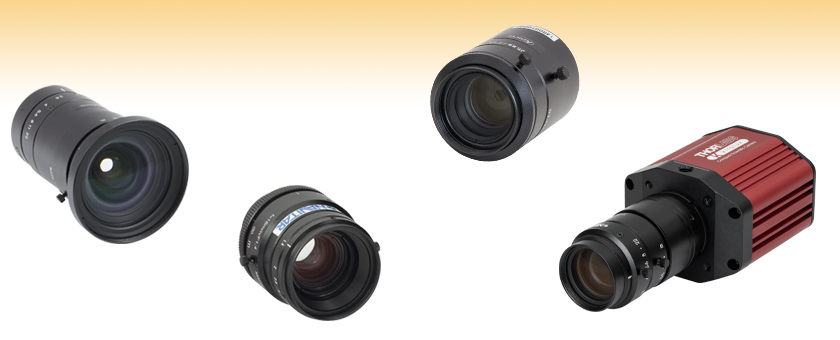
MVL25TM23
25 mm Fixed Focal Length,
High Resolution (10 MP),
2/3" Format, C-Mount
MVL12M43
12 mm Fixed Focal Length,
4/3" Format, C-Mount
MVL16M1
16 mm Fixed Focal Length,
1" Format, C-Mount
Application Idea
MVL50M23 C-Mount Camera Lens with sCMOS Camera
- Lenses for 1/2", 2/3", 1", and 4/3" Sensor Formats
- C-Mount (1.00"-32) Threaded Lenses
- Zoom or Fixed Focal Length Lenses

Please Wait
Features
- Lenses with Fixed Focal Lengths of 3.5 mm to 100 mm
- Zoom Lens with Focal Length Range of 18 mm to 111 mm
- High-Resolution (10 Megapixels) Fixed Focal Length Lenses Available
- Fast Lenses with Large Maximum Apertures up to f/0.95
- 1/2", 2/3", 1", or 4/3" Lens Design Formats
- Manual Focus and Aperture Control
- Lenses with C-Mount (1.00"-32) Thread are Compatible with Most of Our CMOS Cameras
The Camera Lenses sold here are specifically designed to be used with 1/2", 2/3", 1", or 4/3" sensor format cameras and are well-suited for machine vision applications. Thorlabs offers lenses with fixed focal length (i.e., prime lenses) that offer superior optical performance at focal lengths from 3.5 mm to 100 mm, as well as a 2/3" format zoom lens with an adjustable focal length of 18 mm to 111 mm. All lens models are equipped with lockable focus and aperture rings.
Some lenses are designed for improved aperture or resolution performance. Because of the simplified optical design, some prime lenses are designed as fast lenses with large maximum apertures up to f/0.95 (see the Camera Lens Tutorial tab for details). Thorlabs also offers 2/3" format lenses at 5 mm, 25 mm, and 50 mm fixed focal lengths that feature 200 lp/mm resolution, commonly referred to as 10 megapixel (10 MP) lenses. These lenses are the ideal choice for high-end inspection or high-resolution imaging applications. For more information on these lenses, Modulation Transfer Function (MTF) plots can be found in the 10 MP Lens Data tab above.
Selecting an appropriate camera and lens pair can significantly improve image quality. A lens should generally not be used with camera sensors that have a larger format than the lens. While these lenses can be used with a smaller format camera, the resultant image will be cropped (see Camera Lens Tutorial tab for details). See the table below for a list of sensor formats for Thorlabs cameras.
Lenses that are equipped with C-Mount (1.00"-32) threads are fully compatible with most of our C-Mount CMOS Cameras and our line of Scientific-Grade Cameras. CS-Mount cameras are compatible with these lenses when using a CML05 CS- to C-Mount adapter.
| Compatible Cameras | ||||
|---|---|---|---|---|
| Sensor Format | Compact Scientific sCMOS Camera | Compact Scientific CMOS Cameras | ||
| 1/3" a | - | - | ||
| 1/2.9" a | - | Zelux® 1.6 MP CMOSb | ||
| 1/2" | - | Kiralux® 1.3 MP CMOS | ||
| 1/1.8" a | - | - | ||
| 2/3" | Quantalux® 2.1 MP sCMOS | Kiralux® 5 MP CMOS (Monochrome, Color, or Polarization) |
||
| 1/1.2" a | - | Kiralux® 2.3 MP CMOS | ||
| 1" | - | Kiralux® 8.9 MP CMOS | ||
This tab contains performance plots for the MVL5TM23, MVL25TM23, and MVL50TM23 10 megapixel lenses sold on this page. Shown below are modulation transfer function (MTF) plots for each lens calculated for an infinite object distance. The MTF is calculated at four different full-angle fields of view (FOV) that span the specified FOV of each lens, as well as the diffraction-limited case.
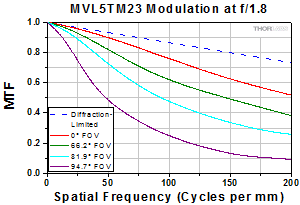
Click to Enlarge
Click Here for Raw Data
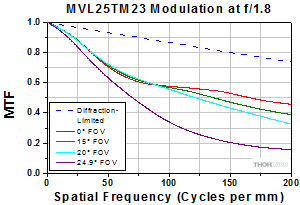
Click to Enlarge
Click Here for Raw Data
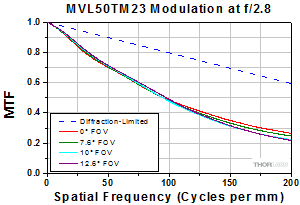
Click to Enlarge
Click Here for Raw Data
Aperture
The aperture of the lens controls the amount of light that a lens can collect; the more light a lens collects, the brighter the image. Because of this, the aperture size affects the exposure time and therefore the speed of the camera. Thorlabs provides the maximum aperture size in the tables below for each lens in terms of the f-number, which is expressed using the symbol f/# (e.g., f/1.4). As the f-number increases, the aperture opening becomes smaller and less light is collected by the lens.
Specifically, f-number is defined as:
where f/# is the f-number, f is the focal length and d is the entrance pupil diameter.
Camera lenses that can collect a lot of light (i.e., a low f-number) are known as fast lenses as they can be used with shorter exposure times and are ideal for low-light conditions. For example, a 50 mm focal length lens with a f/1.4 aperture has a bigger aperture and is therefore faster than a lens at the same focal length with a f/2.5 aperture. While using larger apertures increases light collection, doing so reduces the axial in-focus region of the image, known as the depth of field. To illustrate the effect of different aperture sizes visually, the table below shows a sequence of images taken with the same lens (MVL12M43 on a DCU224C 1/2" format camera) for increasing f-numbers. Because the images were taken at constant exposure, for each f/# increase (by a factor of ~1.4) the amount of light collected by the lens is reduced by half.
| Aperture Size Effects (Click Photos to Enlarge) | ||||||
|---|---|---|---|---|---|---|
| f/2 | f/2.8 | f/4 | f/5.6 | f/8 | f/11 | f/22 |
 |
 |
 |
 |
 |
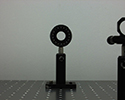 |
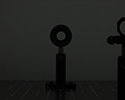 |
| Click for Raw Image | Click for Raw Image | Click for Raw Image | Click for Raw Image | Click for Raw Image | Click for Raw Image | Click for Raw Image |
Focal Length
The focal length (FL) is roughly defined as the distance from principal plane to the focal plane. For a camera lens, the focal length determines the field of view of the camera system; the longer the focal length, the smaller the field of view. As a general guideline, a 50 mm focal length lens and 35 mm format camera combination produces roughly the same field of view as the human eye (~53° diagonal). The table below lists the focal lengths needed to achieve the same field of view as the human eye for different sensor formats.
There are three general classifications for lenses related to the image field of view. A lens with a focal length close to the diagonal length of the sensor format produces an image with a near-human field of view and is considered a "normal" lens for that sensor format. A wide-angle lens has a focal length shorter than normal, which produces a wider field of view but has a tendency to exhibit barrel distortion effects towards the edge of the image. Finally, a lens with a focal length longer than normal is known as a telephoto lens, which has a smaller field of view and a greater magnification of objects in the image.
DCU224C 1/2" Format CCD Camera
To illustrate this, the sequence of three images to the right were taken with the same camera with three different lenses. As focal length of the lens increases, magnification of the objects in the photos increases while the field of view decreases. The items in the image are each roughly spaced in 10" (254 mm) increments in the following order: Polaris™ Fixed Monolithic Mirror Mount (10" from camera), Ø1/2" post with KM100 mirror mount (20" from camera), and post-mounted RSP1 rotation mount (30" from camera). The MVL4WA used to shoot the first image is a wide angle lens which clearly distorts the door frame on the left edge of the image.
| Sensor/Lens Combinations for Human Eye Field of View | |
|---|---|
| Sensor Format | Lens Focal Length |
| 1/3" (6 mm Diagonal) | 6.9 mm |
| 1/2.9" (6.2 mm Diagonal) | 7.1 mm |
| 1/2" (8 mm Diagonal) | 9.2 mm |
| 1/1.8" (9 mm Diagonal) | 10.4 mm |
| 2/3" (11 mm Diagonal) | 12.7 mm |
| 1/1.2" (13.3 mm Diagonal) | 15.3 mm |
| 1" (16 mm Diagonal) | 18.5 mm |
| 4/3" (23 mm Diagonal) | 26.6 mm |
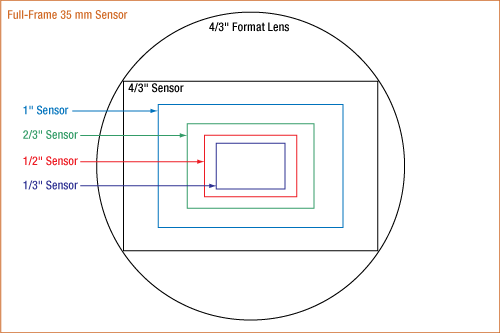
| Crop Factors for Different Sensor/Lens Combinationsa | ||||||||
|---|---|---|---|---|---|---|---|---|
| Sensor Format | Lens Design Format | |||||||
| 1/3" | 1/2.9" | 1/2" | 1/1.8" | 2/3" | 1/1.2" | 1" | 4/3" | |
| 1/3" (6 mm Diagonal) | 1 | 1.03 | 1.33 | 1.50 | 1.83 | 2.22 | 2.67 | 3.83 |
| 1/2.9 (6.2 mm Diagonal) | - | 1 | 1.29 | 1.45 | 1.77 | 2.14 | 2.58 | 3.71 |
| 1/2" (8 mm Diagonal) | - | - | 1 | 1.13 | 1.38 | 1.66 | 2.00 | 2.88 |
| 1/1.8" (8.93 mm Diagonal) | - | - | - | 1 | 1.22 | 1.48 | 1.78 | 2.56 |
| 2/3" (11 mm Diagonal) | - | - | - | - | 1 | 1.21 | 1.45 | 2.09 |
| 1/1.2" (13.3 mm Diagonal) | - | - | - | - | - | 1 | 1.2 | 1.73 |
| 1" (16 mm Diagonal) | - | - | - | - | - | - | 1 | 1.44 |
| 4/3" (21.6 mm Diagonal) | - | - | - | - | - | - | - | 1 |
Combining Different Camera Sensor and Lens Formats
Modern cameras that use CCD or CMOS sensors are specified for a camera sensor format, and similarly, lenses are designed to provide optimal imaging for a specific camera format. This format designation (e.g., 1/2", 2/3", 4/3") is a hold-over convention from when video was recorded using cathode-ray tubes and refers to the outer diameter of the video tube required for a given image size. The diagram to the right illustrates the size difference between several standard camera formats. In the ideal imaging system, a camera and lens would be designed for the same format, however, it is also possible to use camera/lens combinations with different formats. Doing this will have an effect, either vignetting or cropping, on the resulting image.
Vignetting
Vignetting occurs when the lens format is smaller than the camera format. When this occurs, the area of the sensor is incompletely exposed, causing a dark ring to appear around the borders of the image. The vignetting effect is illustrated in the two images below, which were both captured using the same 4/3" format camera. In the image to the left, using a 12 mm focal length, 4/3" format lens produces a full image with slight dimming around the edges. This minor example of vignetting is due to the lens design which has decreased transmission at the edge of the lens. On the other hand, a 2/3" format lens at the same focal length produces a prominent dark ring around the photo edge. As the latter example is very visually apparent, we do not recommend using lenses with smaller formats than the camera sensor for imaging.
Vignetting: 8051M-GE 4/3" Format Camera
| Adjusted Focal Length (AFL) for Various Sensor Formatsa | ||||||||
|---|---|---|---|---|---|---|---|---|
| Item # | 1/3" | 1/2.9" | 1/2" | 1/1.8" | 2/3" | 1/1.2" | 1" | 4/3" |
| MVL4WA | 4.7 mm | 4.5 mm | 3.5 mm | - | - | - | - | - |
| MVL5WA | 6.0 mm | 5.8 mm | 4.5 mm | - | - | - | - | - |
| MVL5M23 | 9.2 mm | 8.8 mm | 6.9 mm | 6.2 mm | 5.0 mm | - | - | - |
| MVL5TM23 | 9.2 mm | 8.8 mm | 6.9 mm | 6.2 mm | 5.0 mm | - | - | - |
| MVL6WA | 8.0 mm | 7.7 mm | 6.0 mm | - | - | - | - | - |
| MVL8M23 | 14.7 mm | 14.1 mm | 11.0 mm | 9.9 mm | 8.0 mm | - | - | - |
| MVL8M1 | 21.3 mm | 20.5 mm | 16.0 mm | 14.3 mm | 11.6 mm | 9.6 mm | 8.0 mm | - |
| MVL12WA | 6.0 mm | 15.4 mm | 12.0 mm | - | - | - | - | - |
| MVL12M23 | 22.0 mm | 21.2 mm | 16.5 mm | 14.8 mm | 12.0 mm | - | - | - |
| MVL12M1 | 32.0 mm | 30.8 mm | 24.0 mm | 21.5 mm | 17.5 mm | 14.4 mm | 12.0 mm | - |
| MVL12M43 | 43.2 mm | 41.6 mm | 32.4 mm | 29.0 mm | 23.6 mm | 19.4 mm | 16.2 mm | 12.0 mm |
| MVL16M23 | 29.3 mm | 28.3 mm | 22.0 mm | 19.7 mm | 16.0 mm | - | - | - |
| MVL16M1 | 42.7 mm | 41.1 mm | 32.0 mm | 28.7 mm | 23.3 mm | 19.2 mm | 16.0 mm | - |
| MVL17HS | 45.3 mm | 43.7 mm | 34.0 mm | 30.5 mm | 24.7 mm | 20.4 mm | 17.0 mm | - |
| MVL25M23 | 45.8 mm | 44.1 mm | 34.4 mm | 30.8 mm | 25.0 mm | - | - | - |
| MVL25TM23 | 45.8 mm | 44.1 mm | 34.4 mm | 30.5 mm | 25.0 mm | - | - | - |
| MVL25HS | 66.7 mm | 64.2 mm | 50.0 mm | 44.8 mm | 36.4 mm | 30.0 mm | 25.0 mm | - |
| MVL25M1 | 66.7 mm | 64.2 mm | 50.0 mm | 44.8 mm | 36.4 mm | 30.0 mm | 25.0 mm | - |
| MVL25M43 | 90.0 mm | 86.7 mm | 67.5 mm | 60.5 mm | 49.1 mm | 40.5 mm | 33.8 mm | 25.0 mm |
| MVL35M23 | 64.2 mm | 61.8 mm | 48.1 mm | 43.1 mm | 35.0 mm | - | - | - |
| MVL35M1 | 93.3 mm | 89.9 mm | 70.0 mm | 62.7 mm | 50.9 mm | 42.0 mm | 35.0 mm | - |
| MVL50M23 | 91.7 mm | 88.3 mm | 68.8 mm | 61.6 mm | 50.0 mm | - | - | - |
| MVL50TM23 | 91.7 mm | 88.3 mm | 68.8 mm | 61.6 mm | 50.0 mm | - | - | - |
| MVL50HS | 133.3 mm | 128.4 mm | 100.0 mm | 89.6 mm | 72.7 mm | 60.0 mm | 50.0 mm | - |
| MVL50M1 | 133.3 mm | 128.4 mm | 100.0 mm | 89.6 mm | 72.7 mm | 60.0 mm | 50.0 mm | - |
| MVL75M23 | 137.5 mm | 132.4 mm | 103.1 mm | 92.4 mm | 75.0 mm | - | - | - |
| MVL75M1 | 200.0 mm | 192.6 mm | 150.0 mm | 134.4 mm | 109.1 mm | 90.0 mm | 75.0 mm | - |
| MVL100M23 | 183.3 mm | 176.6 mm | 137.5 mm | 123.2 mm | 100.0 mm | - | - | - |
Cropping
When the lens format is larger than the camera format, the effect on the resultant image is known as cropping. In this case, a full image is produced but at a smaller size (i.e. cropped) because the sensor is only capturing a fraction of the complete image. A crop factor or focal length multiplier quantifies the amount of cropping and is defined as the ratio of the diagonal length of the lens' design format divided by the diagonal length of the sensor format. The crop factor for all possible 1/3", 1/2.9", 1/2", 1/1.8", 2/3", 1", and 4/3" format lens/sensor combinations are shown in the table to the right.
An image that is cropped appears as if it was taken with a lens of higher focal length (i.e. a smaller field of view), but does not magnify the image. The cropping effect can be quantified using an adjusted focal length (defined as the crop factor multiplied by the lens focal length). For example, an image taken using a 1" format, 50 mm focal length lens with a 1/2" format sensor will produce an image with an adjusted focal length of 100 mm. While the field of view is reduced as if using a 100 mm lens, objects in the image will remain at the same size. The table to the right lists all of the lenses offered on this page with the adjusted focal length for different sensor formats.
The images below illustrate this effect visually using two images taken using the same lens with 1/2" and 1/3" format cameras. The image taken using the smaller 1/3" format camera produces an image that is cropped compared to the image taken using the 1/2" format camera. Note, however, that the objects in both images remain at the same magnification.
Cropping: MVL8M1 8 mm FL, 1" Format Lens
AFL = 21.4 mm
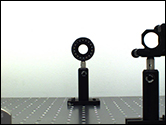
Click to Enlarge
Click Here for Raw Image (1024 x 768)
| Posted Comments: | |
jdelia
(posted 2024-10-23 12:31:57.0) Thank you for contacting Thorlabs. You may request a quote for one of our items by reaching out to your local sales team at sales@thorlabs.com or 973-300-3000, or by adding the item to your shopping cart directly on the website. ILIYA SHOFMAN
(posted 2024-10-13 16:11:53.243) Hello - I'm curious to understand what the difference is between the MVL50M23 and the MVL50TM23. The latter is "10MP Compatible" and is also (therefore) much more expensive.
Granted, I could fathom that the "10MP" label means the camera can support higher resolution imaging. But how much worse is the resolution for the regular variant? Is there perhaps a section in the Tutorials that explains this? jdelia
(posted 2024-10-14 03:55:18.0) Thank you for contacting Thorlabs. For these two parts, we specify the following: Center 100 lp/mm, Corner 80 lp/mm for MVL50M23 and Center 200 lp/mm, Corner 160 lp/mm MVL50TM23. While we do not offer an explicit tutorial on these lenses, we have reached out to you directly via email to discuss your application. ILIYA SHOFMAN
(posted 2024-10-04 17:23:30.04) Hello,
I'm working on an optical model that uses the MVL100M23. Is the ZEMAX BlackBox model available for this product?
Thank you,
Iliya Shofman. jpolaris
(posted 2024-10-07 01:11:13.0) Thank you for contacting Thorlabs. Requests for additional specs, data, files, and documentation can be made by emailing us at techsupport@thorlabs.com. We have reached out to you directly with the Zemax files you have requested. ILIYA SHOFMAN
(posted 2024-09-29 19:06:57.097) Hello,
I'm interested in purchasing the MVL100M23 (100mm focal length f/2.8 lens). I'd like to examine the MTF data, transmissivity data, and the enclosed energy curves for this lens. Would it be possible for me to access this information?
Regards,
Iliya Shofman. jpolaris
(posted 2024-09-30 04:40:43.0) Thank you for contacting Thorlabs. Additional data and specifications can be requested by emailing us at techsupport@thorlabs.com. I have reached out to you directly with additional information. Matyas Priban
(posted 2024-08-15 12:36:39.997) There seems to be a discrepancy in dimensions between the step model and the CAD drawing available for download for this product. The length between the flange and the end of the C-mount thread in the CAD drawing is shown to be 4.1 mm, while in the step model I measured it to be 6.52 mm. Natan Osterman
(posted 2024-06-11 10:35:13.703) Hi,
a measurement given in the documentation of MVL50M23 is wrong!
The diameter of the back part of the objective (close to the thread) is not 33.0 mm but rather 34.0 mm! This error has just costed me 500€ as many objective holders have already been manufactured and anodized but now the lens does not fit in.
Best regards,
Natan Osterman cdolbashian
(posted 2024-08-14 12:07:18.0) Thank you for reaching out to us with this inquiry. Apparently this was a mis-documentation by our vendor on their website, which propagated to our own website. At the time of posting, we are working with our vendor to get updated models and drawings. I have contacted you directly to discuss how we can compensate you. Peter Rogin
(posted 2024-03-04 08:47:35.083) The mechanical dimensions of the recently purchased lens differ from the technical drawings available online. As a result, a customized mount had to be redesigned. Not a big deal, but having the drawings up to date would certainly be helpful. jdelia
(posted 2024-04-04 12:52:23.0) Thank you for contacting Thorlabs. I reached out to you to clarify the discrepancies, and after discussing it with our vendor, Navitar, I confirmed that our drawing was indeed out-of-date. We are currently looking into updating the drawing for the MVL100M23 on our website. Shahad Al-Gburi
(posted 2024-01-09 07:50:45.71) Hallo,
Wir sind an 4/3"-Objektiven interessiert, aber uns fehlen noch Informationen über die Auflösung in MP und die Pixelgröße. Können Sie mir die Datenblätter zusenden?
Mit freundlichen Grüßen jpolaris
(posted 2024-01-12 11:40:26.0) Viele Dank für Ihre Anfrage. Für gewöhnlich sind wir bei Artikeln von Drittanbietern auf die von ihnen bereitgestellten Daten beschränkt. Ich werde mich direkt mit Ihnen in Verbindung setzen und Ihnen Auflösungsdaten in Form von MTF-Diagrammen zukommen lassen. -- Translation of feedback: "We are interested in 4/3" lenses, but we still lack information about the resolution in MP and pixel size. Can you send me the data sheets?" Answer: Thank you for contacting Thorlabs. As is typical for parts we receive from vendors, we are oftentimes limited to the data they provide. I have reached out to you directly with resolution data in form of MTF plots. Felix Wälti
(posted 2023-11-06 15:12:00.343) The delivered objektive is 7mm larger in the length than specified on drawing and CAD file. cdolbashian
(posted 2023-11-13 02:43:27.0) Thank you for finding this on our webpage! We are updating the CAD document to be accurate to the physical optic. Geer Teng
(posted 2023-11-06 13:17:01.42) Hi, may I request for a raw data about the transmission rate of the MVL50M23? I ordered it last Dec., but it seems no related transmission rate on the website. cdolbashian
(posted 2023-11-13 02:43:26.0) Thank you for reaching out to us with this inquiry. Unfortunately, we do not have access to the transmission for this lens assembly. Perhaps if you have a specific wavelength in mind we can test a transmission for you. I have reached out to you directly to further this discussion. Shao-Kui Zhou
(posted 2023-03-02 20:48:02.69) Can you provide the size and position of the entrance pupil of the following lens models? thank you
1.MVL16M1
2.MVL17HS
3.MVL12M43
4.MVL12M1
5.MVL8M1
6.MVL8M23
7.MVL4WA
8.MVL5WA
9.MVL5M23
10.MVL5TM23 jgreschler
(posted 2023-03-02 02:24:40.0) Thank you for reaching out to Thorlabs. The entrance pupil diameter is variable for these lenses as there is an internal iris that can expand and contract to make the lens faster or slower. The aperture will always be centered on the optical axis. user
(posted 2022-08-31 14:20:31.447) I have two lenses (MVL4WA and MVL100M23).
Can I receive MTF data of these lenses?
Please send me MTF data to my e-mail. ksosnowski
(posted 2022-09-22 04:56:25.0) Thanks for reaching out to Thorlabs. We do have MTF data from the vendor for most of the camera lenses like this in our catalogue. I have reached out directly to discuss your application further. Graham Little
(posted 2022-06-30 17:04:17.657) Can you please tell me the maximum / minimum overall length for the MVL25M23 lens ksosnowski
(posted 2022-07-08 04:34:10.0) Thanks for reaching out to Thorlabs. The minimum length of this lens is 1.8625 inches and the maximum length when extended is 2.025 inches. shitao Tan
(posted 2021-05-30 15:57:22.977) Can you provide me with the zemax file for this model lens, I want to use it in the simulation of a spectrometer system to test whether it meets my requirements. YLohia
(posted 2021-06-04 10:13:17.0) Hello, thank you for contacting Thorlabs. We get the MVL50M1 from Navitar and, unfortunately, they do not provide Zemax files of any sort for this. user
(posted 2021-05-11 23:36:04.28) Could you give me a transparency graph of MVL7000?
Please contact us by e-mail. YLohia
(posted 2021-05-12 11:03:29.0) I have reached out to you directly with the transmission plot. user
(posted 2021-03-19 02:50:06.97) Hi I'm interested in using the MVL50M23 at 850nm. Can you please send me some transmission and MTF data vs wavelength for this lens so that I can decide whether this lens will perform acceptably at my wavelength.
thanks
Dirk YLohia
(posted 2021-03-19 03:14:01.0) Hello Dirk, I have reached out to you directly with this information. Sebastian Harenbrock
(posted 2021-03-17 14:00:55.69) What is the back focal length (BFL) of the MVL35M23 lens? Also, is the effective focal length (EFL) precisely 35mm, or slightly off? cdolbashian
(posted 2021-05-12 04:27:43.0) Thank you for reaching out to us at ThorLabs! The MVL35M23 has a BFL of 20.10mm, and an EFL of 34.991mm for visible light. Johannes Rebling
(posted 2019-10-07 07:24:41.087) Hi Thorlabs, is it possible to use the MVL7000 with a filter wheel? If so, would it need to be placed before the lens, or can it be placed between lens and camera? YLohia
(posted 2019-10-08 08:53:06.0) Hello, thank you for contacting Thorlabs. The filter should be placed before the lens. You may use the MVL7000 with the LCFW5 filter wheel by using the SM2A52 thread adapter. Please note that there may be some loss in the clear aperture. andychain
(posted 2018-10-14 16:00:59.56) Hello, I want integrate DCC1645C CCD with MVL35M23 lens into 30 mm cage system. But I cannot find any instructions. Can anyone tell how to do this? Thanks. llamb
(posted 2018-10-15 11:45:14.0) Thank you for contacting Thorlabs. The MVL35M23 is directly compatible with the DCC1645C. However, the MVL35M23 is not 30 mm cage compatible. You can consider using its M27 x 0.5 filter threading with our SM1A36 adapter to make it SM1 compatible, which can then be incorporated into our cage systems more easily. sanket.shah
(posted 2018-06-12 12:27:28.923) I would like to know if a blackbox model in Zemax of MVL7000 is possible to be given for simulation. This lens is very useful but I need to model it in my setup. Thank you! YLohia
(posted 2018-06-12 08:56:51.0) Hello, thank you for contacting Thorlabs. We get the MVL7000 from Navitar and, unfortunately, they do not provide Zemax files of any sort for this. ns.park
(posted 2016-11-22 16:59:27.83) Hello, I am Nam Su Park in Pusan National University, Korea.
Where can I ZEMAX file about MVL35M1?
If you offer the ZEMAX file of MVL35M1, I would like to get from you. I can't find ZEMAX file on your website now.
Please confirm my message and I will wait your reply.
Sincerely,
Nam Su Park. tfrisch
(posted 2016-11-22 07:26:59.0) Hello, thank you for contacting Thorlabs. Unfortunately, the Zemax file is proprietary to Navitar, the manufacturer, and we cannot offer it. I apologize for the inconvenience. zachary.flom
(posted 2016-11-22 01:34:58.423) Are there MTF plots for any lenses other than the MVL5TM23, MVL25TM23, and MVL50TM23? Also, are these white-light MTFs? tfrisch
(posted 2016-11-28 02:18:53.0) Hello, thank you for contacting Thorlabs. I will reach out to you directly about your application. dzack
(posted 2016-05-13 15:25:55.197) Hello. We're using the MVL12M1 lens attached to an iDS camera (http://www.1stvision.com/cameras/IDS/dataman/UI-3370CP-C-HQ.pdf). The lens/iDS combo is looking into the eyepiece of another camera, we'll call it camera B, to take pictures of what a human eye would see looking into camera B. In order to accurately simulate the human eye, the entrance pupil of the MVL12M1 must be located ~25mm from the vertex of the eyepiece element. The issue we're having is how far to place the lens behind camera B's eyepiece, that is, where is the entrance pupil located within the MVL12M1 lens? Thank you. besembeson
(posted 2016-05-17 10:01:08.0) Response from Bweh at Thorlabs USA: The entrance pupil is 19.72mm from the front mechanical surface of the lens. o-leprette
(posted 2015-06-04 12:03:33.227) Hello,
Do you have the MTF curve of this camera lens ? Of other camera lens ?
I would be very grateful,
Thank you,
Olivier besembeson
(posted 2015-08-28 04:53:46.0) Response from Bweh at Thorlabs USA: At the following link under the "10 MP Lens Data", you will find the MTF plots.
http://www.thorlabs.com/NewGroupPage9.cfm?ObjectGroup_ID=1822 ekocabas
(posted 2015-02-05 15:08:16.797) Is it possible to use the MVL7000 zoom lens with any of the magnifying lens or extension tubes available under the "High-Magnification Zoom Lens Systems for Machine Vision" section so as to effectively have a teleconverter to multiply the zoom range? If not, can you recommend any teleconverters compatible with MVL7000 ? jlow
(posted 2015-02-10 11:59:37.0) Response from Jeremy at Thorlabs: The extension tubes and magnifying lens used in the high-magnification zoom lens systems are not compatible with MVL7000. We do not currently sell any teleconverters compatible with the MVL7000. I will contact you directly to discuss more about this. paul.hockett
(posted 2015-01-28 10:12:56.937) Hi,
Is it possible to get transmission curves for the MVL16M1, or the Navitar lens range in general (assuming they're all pretty similar)?
Also, related to this: do any of the machine vision lenses transmit reasonably well down to around 350nm? For our application we'd ideally like to transmit light ~350 to 500nm, but can probably tolerate a cut-off of ~400nm (as seems typical VIS-optimized lenses) if we have to.
Thanks,
Paul jlow
(posted 2015-01-29 03:27:24.0) Response from Jeremy at Thorlabs: We are working on putting the transmission curve for the C-mount lenses on the website. Typically these lenses do have poor transmission below 400nm. I will contact you directly to provide the curve for this. fmu
(posted 2014-11-19 20:07:06.533) There is a small typo in the description of the MVL12WA lens: it has an M25.5x0.5 filter thread, not an M30.5x0.5 thread as stated in the table in the "12 mm Fixed Focal Length" section. myanakas
(posted 2014-11-25 04:29:21.0) Response from Mike at Thorlabs: Thank you for your feedback. You are correct, the MVL12WA has an M25.5 filter thread, not an M30.5 x 0.5 thread as stated on the web and in our drawing. We are working on updating this information now. user
(posted 2014-10-23 16:38:21.703) Whats the performance of the MVL5M23 lens around 370 nm? besembeson
(posted 2014-10-23 11:06:59.0) Response from Bweh: We have transmission data between 400nm and 1600nm which I can share with you by email if provided and from that plot, we won't recommend this for that wavelength. jsilver
(posted 2014-03-24 12:25:11.807) What is the operating wavelength range for this lens? jlow
(posted 2014-03-27 11:11:52.0) Response from Jeremy at Thorlabs: These camera lenses are designed for the visible wavelength range. dgardner
(posted 2012-05-09 10:08:00.0) Response from Dave at Thorlabs: Thank you for your question. Your Thorlabs CCD camera is fully compatible with the MVL7000 Zoom Lens, as both feature a C-Mount lens mount. Please note that since the MVL7000 is designed for a 2/3" sensor, a crop factor will be present. Refer to the Specs table in the MVL7000 desicrption for details. Your CCD camera is also compatible with Thorlabs' SM1 lens tube threading, via the included C-Mount to internal SM1 and C-Mount to external SM1 adapters. Please contact techsupport@thorlabs.com if you have any further questions. carlos.jarro
(posted 2012-05-08 15:58:13.0) Hello, I already have a CCD camera which comes with a plastic case. Now I am really needing the MVL7000 zoom lens. You recommend "additional hardware" to mount the camera/lens in your web page. What is the recommended hardware to mount the camera/lens on a cage system? bdada
(posted 2012-03-15 11:49:00.0) Response from Buki at Thorlabs to gilad:
Thank you for your feedback. We are working on getting the MTF curves and will post an update here when we get it. gilad
(posted 2012-03-12 11:02:56.0) Must have MTF for all the lens in order to see if it is good enough. bdada
(posted 2011-10-31 18:28:00.0) Response from Buki at Thorlabs:
Thank you for your feedback. The objective is coated and we will send you a graph that shows the transmission of the objective from 400nm to 1000nm. We will also update our web presentation to include more information. Please contact TechSupport@thorlabs.com if you have further questions. otni
(posted 2011-10-31 06:05:28.0) I am constructing a vision system for hyperspectral imaging, and need an objective that can cover the spectral range from ~450 nm - 1050 nm. But i have not found any description of the coating for your lenses. Can you supply me with this, or tell me how to retrieve it myself?
Kind regards
-Otto Nielsen Thorlabs
(posted 2010-07-14 09:28:06.0) Response from Javier at Thorlabs to steffen.kalfhues: thank you for your feedback. The transmission for the MVL25 camera lens is ~40% in the 340-350 nm range. We currently do not offer lenses specifically designed for use in the UV spectrum. steffen.kalfhues
(posted 2010-07-14 01:49:21.0) Hi,
what will the transmission of the MVL25 @ 343nm be?
Do you offer lenses for explicit use with UV?
Thx Javier
(posted 2010-06-16 10:15:33.0) Response from Javier at Thorlabs to mskiba: you can use our SM1A10 and SM1A9 adapters, along with an SM1 lens tube, to reduce the focusing distance of your lens. I will contact you directly with links for these parts. mskiba
(posted 2010-06-16 05:46:00.0) Do you offer an accesory to reduce minimum focusing distance (i.e. extension tube)?
Thanks Adam
(posted 2010-05-27 17:34:42.0) A response from Adam at Thorlabs to Ron: The transmission of the MVL25 at 365nm is ~40%. ron
(posted 2010-05-27 13:04:12.0) Whats the performance of the MVL25 lens at 365 nm? apalmentieri
(posted 2010-02-24 16:18:33.0) A response from Adam at Thorlabs to Mtrigo: The DCC1545M CMOS camera comes with CS-C mount adapter so you will not need to purchase extra components. mtrigo
(posted 2010-02-24 15:38:58.0) which mounting adapter do I need to use the zoom lens MVL74L with a DCC1545M CMOS camera? I dont think this is clear from the website apalmentieri
(posted 2010-02-08 15:17:03.0) A response from Adam at Thorlabs to Soia: The spectral transmittance of our lenses found on this website are 400-1000nm with a %T>90%. The cameras we offer are based off of silicon technology and would detect light from 400-1100nm(Monochrome only), but the color camera versions have IR filters that filter out the IR light so they would only detect light from 400-700nm. I will email you directly to find out which camera you are referencing so we can provide more accurate data. soia_1_is
(posted 2010-02-07 01:56:09.0) I would like to know what is the spectral transmittance of these cameras and lenses. Too bad the data is not available in the specs.
Jonathan |

| Item # | MVL7002 |
|---|---|
| Focal Length | 18.0 - 111.0 mm |
| Aperture range | f/2.5 - f/16 |
| Min Working Distance | 127.0 mm (5.00") |
| Design Formata | 2/3" |
| Transmission | - |
| Field of View (1")b | N/A |
| Field of View (2/3")b | 5.83° (Min) - 33.98° (Max) |
| Field of View (1/1.8")b | 4.73° (Min) - 27.86° (Max) |
| Field of View (1/2")b | 4.24° (Min) - 25.06° (Max) |
| Field of View (1/3")b | 3.18° (Min) - 18.92° (Max) |
| Filter Threading | M58 x 0.75 |
| Camera Threading | C-Mount (1.000"-32) |
The MVL7002 macro lens features a removable close-up lens for imaging between 5.00" (127.0 mm) and 12.00" (304.8 mm). When removed, the MVL7002 can be used for imaging objects at distances from 19.70 inches" (500.4 mm) to infinity. The lens focus, iris, and zoom are each manually adjustable and lockable.
The MVL7002 lens comes with lens caps for both ends. Due to the weight of the MVL7002, we do not suggest using it with cameras with plastic lens mounts unless the lens is supported by additional hardware.

| Photo (Click to Enlarge) |
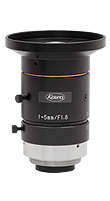 |
||||
| Item # | MVL4WA | MVL5WA | MVL5M23 | MVL5TM23 | MVL6WA |
| Focal Length | 3.5 mm | 4.5 mm | 5 mm | 5 mm | 6 mm |
| Aperture (Max) | f/1.4 | f/1.4 | f/2.8 | f/1.8 | f/1.4 |
| Min Working Distance | 200 mm (7.9") | 200 mm (7.9") | 100 mm (3.9") | 100 mm (3.9") | 200 mm (7.9") |
| Design Formata | 1/2" | 1/2" | 2/3" | 2/3" | 1/2" |
| Transmission | Raw Data |
Raw Data |
Raw Data |
- | Raw Data |
| 10 MP Compatible (Click for MTF Plot) |
No | No | No | Yesb | No |
| Field of View (2/3")c | N/A | N/A | 94.7° | 94.7° | N/A |
| Field of View (1/1.8")c | N/A | N/A | 84.0° | 84.0° | N/A |
| Field of View (1/2")c | 132.1° | 98.2° | 77.3° | 77.3° | 69.4° |
| Field of View (1/3")c | 81.2° | 67.4° | 61.9° | 61.9° | 51.1° |
| Filter Threading | - | - | M40.5 x 0.5 | M46 x 0.75 | M25.5 x 0.5 |
| Camera Threading | C-Mount (1.00"-32) | ||||

| Photo (Click to Enlarge) |
||
| Item # | MVL8M23 | MVL8M1 |
| Focal Length | 8 mm | 8 mm |
| Aperture (Max) | f/1.4 | f/1.4 |
| Min Working Distance | 100 mm (3.9") | 100 mm (3.9") |
| Design Formata | 2/3" | 1" |
| Transmission | Raw Data |
Raw Data |
| Field of View (1")b | N/A | 92.4° |
| Field of View (1/1.2")c | N/A | 81.5° |
| Field of View (2/3")b | 66.7° | 70.7° |
| Field of View (1/1.8")b | 57.4° | 59.1° |
| Field of View (1/2")b | 52.0° | 53.5° |
| Field of View (1/3")b | - | 41.3° |
| Filter Threading | M27 x 0.5 | M55 x 0.75 |
| Camera Threading | C-Mount (1.00"-32) | |

| Photo (Click to Enlarge) |
||||
| Item # | MVL12WA | MVL12M23 | MVL12M1 | MVL12M43a |
| Focal Length | 12 mm | 12 mm | 12 mm | 12 mm |
| Aperture (Max) | f/2.8 | f/1.4 | f/1.4 | f/2.0 |
| Min Working Distance | 300 mm (11.8") | 150 mm (5.9") | 300 mm (11.8") | 100 mm (3.9") |
| Design Formatb | 1/2" | 2/3" | 1" | 4/3" |
| Transmission | Raw Data |
Raw Data |
Raw Data |
- |
| Field of View (4/3)c | N/A | N/A | N/A | 87.6° |
| Field of View (1")c | N/A | N/A | 67.7° | 67.4° |
| Field of View (1/1.2")d | N/A | N/A | 57.8° | 58.9° |
| Field of View (2/3")c | N/A | 46.8° | 48.3° | 49.2° |
| Field of View (1/1.8")c | N/A | 39.1° | 39.8° | 41.1° |
| Field of View (1/2")c | 38.5° | 35.0° | 35.7° | 36.9° |
| Field of View (1/3")c | 28.1° | 26.6° | 27.9° | 28.1° |
| Filter Threading | M25.5 x 0.5 | M27 x 0.5 | M35.5 x 0.5 | M55 x 0.75 |
| Camera Threading | C-Mount (1.00"-32) | |||

|
Photo |
|||
| Item # | MVL16M23 | MVL16M1 | MVL17HS |
| Focal Length | 16 mm | 16 mm | 17 mm |
| Aperture (Max) | f/1.4 | f/1.4 | f/0.95 |
| Min Working Distance | 200 mm (7.9") | 300 mm (11.8") | 500 mm (19.7") |
| Design Formata | 2/3" | 1" | 1" |
| Transmission | Raw Data |
Raw Data |
Raw Data |
| Field of View (1")b | N/A | 54.4° | 50.4° |
| Field of View (1/1.2")c | N/A | 46.0° | 42.6° |
| Field of View (2/3")b | 37.0° | 38.3° | 35.9° |
| Field of View (1/1.8")b | 30.2° | 31.4° | 29.7° |
| Field of View (1/2")b | 27.0° | 28.1° | 26.5° |
| Field of View (1/3")b | 20.4° | 21.6° | 20.0° |
| Filter Threading | M27 x 0.5 | M35.5 x 0.5 | M40.5 x 0.5 |
| Camera Threading | C-Mount (1.00"-32) | ||

| Photo (Click to Enlarge) |
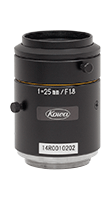 |
||||
| Item # | MVL25M23 | MVL25TM23 | MVL25HS | MVL25M1 | MVL25M43 |
| Focal Length | 25 mm | 25 mm | 25 mm | 25 mm | 25 mm |
| Aperture (Max) | f/1.4 | f/1.8 | f/0.95 | f/1.4 | f/2.0 |
| Min Working Distance | 200 mm (7.9") | 100 mm (3.9") | 500 mm (19.7") | 300 mm (11.8") | 150 mm (5.9") |
| Design Formata | 2/3" | 2/3" | 1" | 1" | 4/3" |
| 10 MP Compatible (Click for MTF Plot) |
No | Yesb | No | No | No |
| Transmission | Raw Data |
- | Raw Data |
Raw Data |
- |
| Field of View (4/3")c | N/A | N/A | N/A | N/A | 49.4° |
| Field of View (1")c | N/A | N/A | 35.5° | 36.6° | 35.5° |
| Field of View (1/1.2")d | N/A | N/A | 29.7° | 30.5° | 30.3 |
| Field of View (2/3")c | 24.3° | 24.9° | 24.8° | 25.2° | 24.8° |
| Field of View (1/1.8")c | 19.6° | 20.5° | 20.4° | 20.5° | 20.4° |
| Field of View (1/2")c | 17.5° | 18.2° | 18.2° | 18.3° | 18.2° |
| Field of View (1/3")c | 13.2° | 13.7° | 13.7° | 13.8° | 13.7° |
| Filter Threading | M27 x 0.5 | M25.5 x 0.5 | M40.5 x 0.5 | M35.5 x 0.5 | M40.5 x 0.5 |
| Camera Threading | C-Mount (1.00"-32) | ||||

| Photo (Click to Enlarge) |
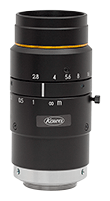 |
|||||
| Item # | MVL35M23 | MVL35M1 | MVL50M23 | MVL50TM23 | MVL50HS | MVL50M1 |
| Focal Length | 35 mm | 35 mm | 50 mm | 50 mm | 50 mm | 50 mm |
| Aperture (Max) | f/2.0 | f/1.4 | f/2.8 | f/2.8 | f/0.95 | f/1.4 |
| Min Working Distance | 200 mm (7.9") | 300 mm (11.8") | 200 mm (7.9") | 100 mm (3.9") | 600 mm (23.6") | 500 mm (19.7") |
| Design Formata | 2/3" | 1" | 2/3" | 2/3" | 1" | 1" |
| 10 MP Compatible (Click for MTF Plot) |
No | No | No | Yesb | No | No |
| Transmission | Raw Data |
- | - | - | - | - |
| Field of View (1")c | N/A | 26.1° | N/A | N/A | 18.2° | 18.0° |
| Field of View (1/1.2")d | N/A | 21.8° | N/A | N/A | 15.0° | 14.7° |
| Field of View (2/3")c | 17.9° | 18.0° | 12.1° | 12.6° | 12.6° | 12.5° |
| Field of View (1/1.8")c | 14.7° | 14.7° | 9.9° | 10.4° | 10.3° | 10.3° |
| Field of View (1/2")c | 13.1° | 13.1° | 8.8° | 9.2° | 9.2° | 9.1° |
| Field of View (1/3")c | 9.8° | 9.8° | - | 6.9° | 6.9° | 6.9° |
| Filter Threading | M27 x 0.5 | M35.5 x 0.5 | M27 x 0.5 | M30.5 x 0.5 | M62 x 0.75 | M40.5 x 0.5 |
| Camera Threading | C-Mount (1.00"-32) | |||||

| Photo (Click to Enlarge) |
|||
| Item # | MVL75M23 | MVL75M1 | MVL100M23 |
| Focal Length | 75 mm | 75 mm | 100 mm |
| Aperture (Max) | f/2.5 | f/1.8 | f/2.8 |
| Min Working Distance | 1.2 m (47.2") | 1 m (39.4") | 2.0 m (78.7") |
| Design Formata | 2/3" | 1" | 2/3" |
| Transmission | - | Raw Data |
- |
| Field of View (1")b | N/A | 12.0° | N/A |
| Field of View (1/1.2")c | N/A | 9.7° | N/A |
| Field of View (2/3")b | 8.3° | 8.3° | 6.3° |
| Field of View (1/1.8")b | 6.8° | 6.8° | 5.1° |
| Field of View (1/2")b | 6.1° | 6.1° | 4.6° |
| Field of View (1/3")b | 4.6° | 4.6° | 3.4° |
| Filter Threading | M34 x 0.5 | M46 x 0.75 | M40.5 x 0.5 |
| Camera Threading | C-Mount (1.00"-32) | ||
 Products Home
Products Home






















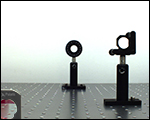
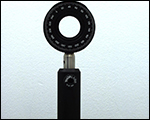
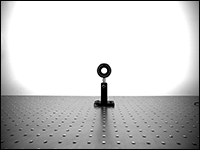
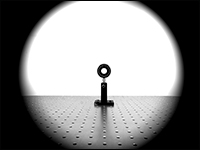

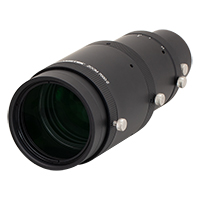
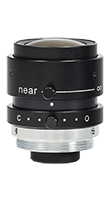
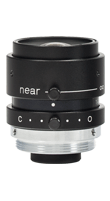
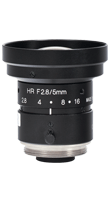
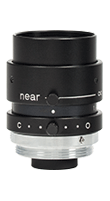
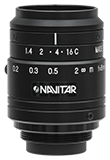
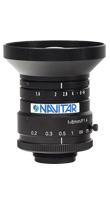
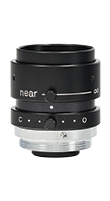
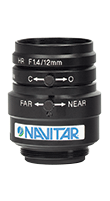
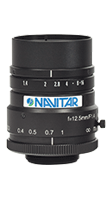
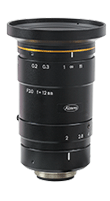
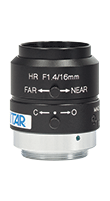
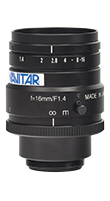
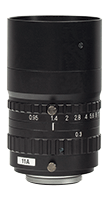
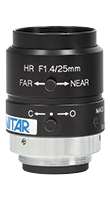
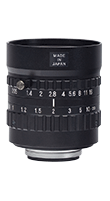
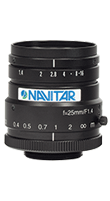
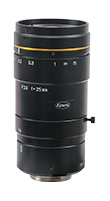
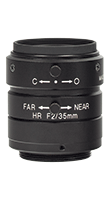
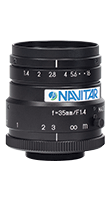
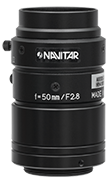
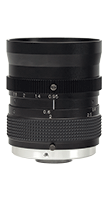
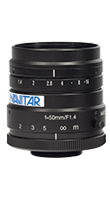

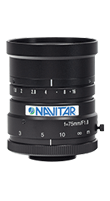
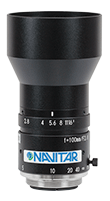
 Standard Fixed and Zoom Camera Lenses
Standard Fixed and Zoom Camera Lenses